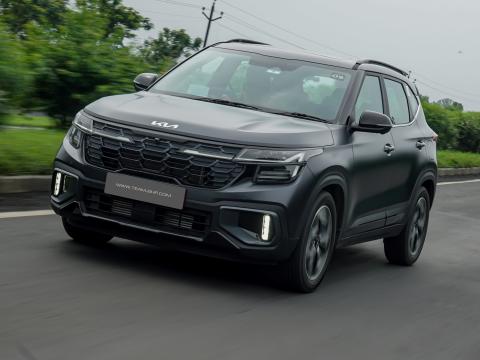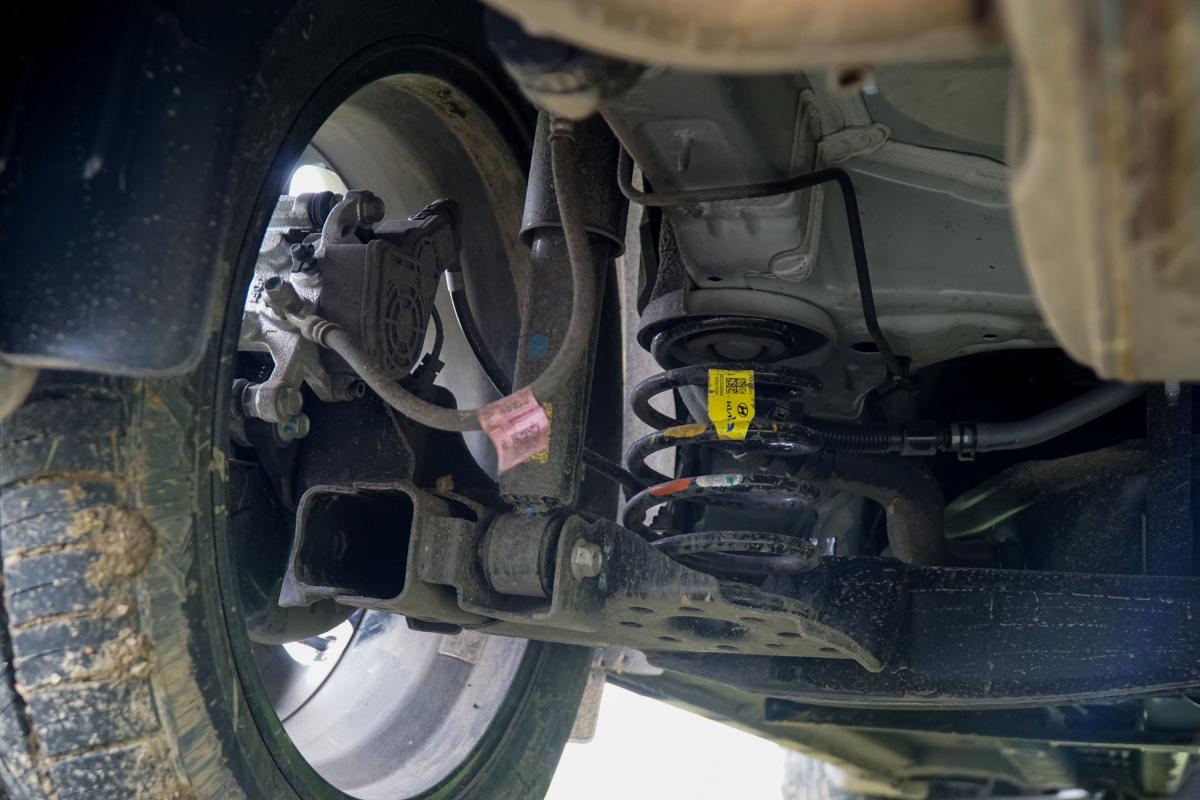The claimed 0-100 km/h time is 8.9 seconds, which means that the Seltos 1.5 turbo petrol is quicker than the 1.4 turbo petrol by 0.9 seconds.
Driving the Kia Seltos 1.5L Turbo-Petrol DCT Automatic
The 138 BHP, 1.4-litre Kappa turbo-petrol engine mated to the 7-speed DCT in the previous Seltos was quite powerful and quick. However, the engine had to be upgraded to meet the emission norms. The result is this Smartstream 1.5-litre turbo-petrol engine which still belongs to the Kappa family and makes an impressive 158 BHP and 253 Nm and is shared with the new Hyundai Verna. It has the highest numbers in its segment. The claimed 0-100 km/h time is 8.9 seconds, which means that the new Seltos 1.5 turbo petrol is quicker than the older 1.4 turbo petrol by 0.9 seconds.
Fire up the engine, and it’s refined at idle, silently purring away. Hyundai-Kia powertrains have always set NVH benchmarks, and this car is no different. Shift to D or R, and it crawls away smoothly. Crawling at city speeds isn’t very dramatic and the 1.5L is very well-behaved. With light to medium throttle inputs, you can go about your daily commute quite comfortably. In comparison with the old 1.4L turbo-petrol, the throttle response is smoother and power delivery is more linear. The 7-speed dual-clutch transmission is also seamless moving through the initial gears. However, we did notice that the gearbox got a little confused on a few instances while driving through some traffic. The engine has a healthy bottom end and thanks to a turbocharger and direct injection, you’re never in a shortage of power. Just floor the accelerator if you want to close a gap in traffic or make that quick overtake and the engine and gearbox will do the rest.
Get on some open roads and you can let the Seltos stretch its legs. Put down your right foot and before you know it, you’ll hit the highway speed limit of 120 km/h. This is the thing with turbo-petrols – flooring the throttle on an empty stretch of road can get addictive. Outright acceleration is great and it feels a little more linear as well compared to say, the 1.5 TSI from the VW-Skoda cars. The turbo delivers a strong mid-range punch that will take care of all the overtaking on the highway. You can cruise along the highway at 100 km/h while the engine spins at a relaxed 1,800 rpm. Even at 120 km/h, the engine felt relaxed with the rev counter reading 2,200 rpm. The Seltos won’t break a sweat cruising at these speeds all day long.
The dual-clutch transmission moves through the gears quite seamlessly. The kickdown response time is quick enough and the gearbox doesn’t hesitate to drop down 3 or even 4 gears at times to get the engine into the powerband. When you are in the mood for some fun in the ghats, switch to Sport mode and start flipping the paddle shifters for manual control. The ECU matches the revs and you’ll hear the sweet note of the engine. Yes, IMO, the engine sounds nice and sporty at high revs. Although Kia has restricted the maximum rpm to 5,900, which is too low, at least the engine sounds great as it reaches that number. The paddle shifters are responsive, and you can extract some performance from the engine using them for quick overtakes or keeping the engine in the powerband over some twisties. There is no “S” mode for the gearbox and pushing the car while in Sport mode, you will find that you cannot rely on the gearbox alone to go fast. You have to take control of the gears using the paddle shifters and manually keep the engine in the power band. I wouldn’t say the same about the DSG in VW-Skoda cars. The gearbox logic in the Taigun and Kushaq 1.5 DSG is way better and more in tune with the requirements of the driver.
The Seltos gets 3 drive modes – Eco, Normal and Sport.
Eco Mode – Engage the Eco mode when you want to extract maximum fuel efficiency. The throttle response is dulled, but given the power on tap, the mode is quite comfortable to use in the city. In fact, we preferred driving in this mode in the city as the car becomes a lot smoother to drive. The Auto Start-Stop feature is activated automatically when you select the Eco mode.
Normal Mode – This is the default mode and just as the name suggests, it’s normal to drive. The difference between Normal and Eco modes is very little.
Sport Mode – Engage this mode when you want the car to be more responsive to your inputs. The throttle response is sharper, and the transmission also holds on to gears a bit longer in this mode. The steering is also noticeably heavier, although not as much as enthusiasts would like (more on this later). The Sport mode isn’t something you’d want to engage in the city as it can get a bit jerky to drive.
Noise, Vibration & Harshness (NVH)
The 1.5-litre unit is very refined overall. At city speeds as well as while cruising at 100 km/h, you can barely hear the engine in the cabin. Even the vibrations are well controlled and cruising with the family on the highway should be comfortable. Kia claims that the dual pipe muffler design for the GT Line variants improves the exhaust noise. In comparison with the previous 1.4L turbo-petrol engine, the noise levels are lower by 1 decibel. Kia also claims that the front roll rod bush has been tuned to reduce high-speed booming.
Road noise from the tyres does creep into the cabin at highway speeds, but the wind noise is kept well in check. The engine has a sporty note to it at high revs.
Mileage & Fuel economy
The Seltos comes equipped with an Auto Start-Stop feature that helps fuel efficiency in city driving conditions. The ARAI-certified fuel efficiency for the 1.5-litre turbo-petrol DCT is 17.9 km/l and that for the 6-speed iMT is 17.7 km/l. Of course, the real-world FE numbers will be much lower considering that turbo-petrol DCTs are very sensitive to the driving style. We’ll wait for some ownership reviews to get a better picture of real-world fuel efficiency.
The 1.5 turbo petrol also features CVVD (Continuously Variable Valve Duration) which is claimed to not only achieve a boost in performance but also an improvement in fuel efficiency. In comparison, in engines with CVVT (Continuously Variable Valve Timing) or CVVL (Continuously Variable Valve Lift), the volume of air admitted is controlled by adjusting the depth of the opening. The duration cannot be controlled here. CVVD regulates the duration of valve opening and closing according to different driving conditions. For instance, when the vehicle is maintaining a constant speed and requires low engine output, CVVD holds open the intake valve until the middle of the compression stroke and from that point holds it closed until near the end of the compression stroke. This helps to improve fuel efficiency by reducing the resistance caused by compression.
1.5L, 4-cylinder turbo-petrol engine makes 158 BHP @ 5,500 rpm and 253 Nm @ 1,500-3,500 rpm:
The turbocharger sits at the back and the 1.5 also features low-pressure exhaust gas recirculation to reduce pumping losses:
The fuel tank capacity remains the same at 50 litres and the new Seltos is E20 compatible:
Suspension
Ride Comfort
This is an area that was concerning for most people in the earlier Seltos. The ride quality was noticeably firm which was a deal breaker for many. However, in the 2023 facelift, Kia has increased the dampening force which has softened up the ride. There’s still an underlying stiffness to the ride quality, but overall the setup is very similar to what you would find in a Creta. It’s much more liveable now and most owners would appreciate this change even on the 18-inch wheels. At slow speeds, the ride isn’t bone-jarring and small bumps and potholes are absorbed comfortably. The suspension works silently in absorbing small bumps and potholes. There’s still some amount of body roll felt inside the cabin over bad roads, but it’s manageable.
The Seltos gets a McPherson strut suspension at the front and a torsion beam axle at the rear. The GTX+ and X-Line variants come equipped with 18-inch alloy wheels shod with 215/55 section tyres. HTX and HTX+ variants get 17-inch wheels shod with 215/60 section tyres. The lower variants (HTE, HTK, HTK+) get 16-inch wheels with 205/65 section tyres.
Handling & Dynamics
Kia may have softened the suspension by a bit, but the Seltos still has an inherently mature suspension setup. It means that the Seltos behaves nicely at high speed. There is no bounciness or that feeling of floatiness. The car is well-planted with satisfactory high-speed stability. While doing triple-digit speeds on the open road, the Seltos displayed good composure. Recovery from expressway undulations is also surprisingly good for a Korean car.
In the area of dynamics, the Seltos is a clean & predictable handler. Through fast corners, the car remains sorted and there are no unnerving surprises. Of course, due to its height, some body roll is present, but it is well-controlled and one can push it through corners confidently. The difference between the previous setup and this one is little and you will notice only when you’re on the limit. Good to know that all variants are equipped with ESP which can be a lifesaver in emergencies. Our test car was shod with JK UX Royale tyres whose grip levels were average. BHPians looking to extract some performance might want to upgrade to richer Michelin or Yokohama rubber.
Steering
The Seltos gets a well-tuned EPS steering. It is light & smooth in the city. As the speedometer climbs, the EPS feels reasonably direct and fast too. The fair all-round visibility, smooth gearboxes (automatics in particular) and light controls make this crossover easy to drive in urban conditions. On the highway, the steering feels stable and has no nervousness.
Braking
Kia has made all-wheel disc brakes standard across all variants. Additionally, you also get brake assist and ABS. While braking from high speeds, the car stops in a straight line without any drama. No complaints in the braking area. The brake pedal felt extremely sharp to the inputs and you have to be very gentle with the application to decelerate smoothly.
Niggles & Problems
The standard warranty of the Seltos is 3 years for unlimited km which can be extended up to the 5th year. Sadly, Kia doesn’t offer an extended warranty of up to 7 years like Hyundai.
While most of the recent feedback about this 1.5-litre turbo-petrol has been positive, the turbo-petrol engine with the dual-clutch transmission is something you should be careful with. Early owners of the Creta & Seltos 1.4 turbo-petrol DCT did face some gearbox overheating issues. While most of them have been resolved, it’s very much advisable to go for the maximum extended warranty. Don’t even think about it twice, it’s better to be safe than sorry.
Continue reading the discussion on the Kia Seltos facelift on our forum.
Source: Read Full Article




